UAV Communication Recovery under Meteorological Conditions
Abstract
1. Introduction
- (1)
- Drawing on ray tracing simulation data from previous work, we provide a new LoS probability expression for four distinct 3D urban environments.
- (2)
- Using the selected four 3D urban environments, we conduct ray tracing simulations and obtain excessive path loss data for these environments, considering one, two, and three reflections.
- (3)
- We present expressions and associated parameters that illustrate the relationships between the coverage area, optimal UAV height, and compensated path loss in relation to the rainfall rate, liquid water density, and snowfall rate across four urban environments at two distinct frequencies (28 GHz and 71 GHz).
- (4)
- We propose an algorithm for UAVs to restore communication with ground users under varying weather conditions and analyze the time required for communication recovery.
2. System Model
2.1. Line-of-Sight Probability
2.2. Excessive Path Loss
2.3. Specific Attenuation Model for Rain, Fog, Snow, and Gases
2.3.1. Rain
2.3.2. Fog
2.3.3. Snow
2.3.4. Gas
3. Methods
3.1. UAV Coverage Radius with Elevation Angle Considering Gaseous Attenuation Only
3.2. UAV Coverage Radius with Elevation Angle under Different Weather Conditions
3.3. The Impacts of , , and on UAV–Ground Communications
3.3.1. Influence of , , and on the Maximum Coverage Area of the UAV
3.3.2. Effects of , , and on the Optimal Height of the UAV
3.3.3. Compensated Path Loss in UAV–Ground Communications
4. UAV Communication Recovery Strategy with Results
4.1. Fitted Curve Expressions for UAV’s Maximum Coverage Area (), Optimal Height (), and Compensated Path Loss ()
4.2. UAV Communication Recovery Algorithm under Meteorological Conditions
| Algorithm 1 UAV Recovery Communications Strategy under Meteorological Conditions |
Input: region type, carrier frequency , height of the UAV h, parameters of LoS probability expression (i, j, k, l, m, n), excessive path loss (, ), maximum path loss , rainfall rate , liquid water density , snowfall rate Output: maximum coverage area , current height of the UAV
|
4.3. Results of UAV Coverage Recovery
5. Conclusions
Author Contributions
Funding
Institutional Review Board Statement
Informed Consent Statement
Data Availability Statement
Acknowledgments
Conflicts of Interest
References
- Dimitrov, K.; Damyanov, I.; Saliev, D.; Valkovski, T. Pasture Research Using Aerial Photography and Photogrammetry. In Proceedings of the National Conference with International Participation (TELECOM), Sofia, Bulgaria, 28–29 October 2021; pp. 121–124. [Google Scholar]
- Flores, D.A.; Saito, C.; Paredes, J.A.; Trujillano, F. Aerial photography for 3D reconstruction in the Peruvian Highlands through a fixed-wing UAV system. In Proceedings of the IEEE International Conference on Mechatronics (ICM), Churchill, VIC, Australia, 13–15 February 2017; pp. 388–392. [Google Scholar]
- Jawad, A.M.; Jawad, H.M.; Nordin, R.; Gharghan, S.K.; Abdullah, N.F.; Abu-Alshaeer, M.J. Wireless Power Transfer With Magnetic Resonator Coupling and Sleep/Active Strategy for a Drone Charging Station in Smart Agriculture. IEEE Access 2019, 7, 139839–139851. [Google Scholar] [CrossRef]
- Jawad, H.M.; Jawad, A.M.; Nordin, R.; Gharghan, S.K.; Abdullah, N.F.; Ismail, M.; Abu-Alshaeer, M.J. Accurate Empirical Path-Loss Model Based on Particle Swarm Optimization for Wireless Sensor Networks in Smart Agriculture. IEEE Sens. J. 2020, 20, 552–561. [Google Scholar] [CrossRef]
- Bai, Z.; Feng, Q.; Qiu, Y. Design and Research of UAV For Campus Express Delivery. In Proceedings of the International Conference on Intelligent Design (ICID), Xi’an, China, 19 October 2021; pp. 208–213. [Google Scholar]
- Feng, K.; Li, W.; Ge, S.; Pan, F. Packages delivery based on marker detection for UAVs. In Proceedings of the Chinese Control And Decision Conference (CCDC), Hefei, China, 22–24 August 2020; pp. 2094–2099. [Google Scholar]
- Cardoso, E.; Natalino, C.; Alfaia, R.; Souto, A.; Araújo, J.; Francês, C.R.L.; Chiaraviglio, L.; Monti, P. A Heuristic Approach for the Design of UAV-Based Disaster Relief in Optical Metro Networks. In Proceedings of the International Conference on Transparent Optical Networks (ICTON), Bari, Italy, 19–23 July 2020; pp. 1–5. [Google Scholar]
- Li, X.; Huang, H.; Savkin, A.V. Autonomous Navigation of an Aerial Drone to Observe a Group of Wild Animals With Reduced Visual Disturbance. IEEE Syst. J. 2022, 16, 3339–3348. [Google Scholar] [CrossRef]
- Zeng, Y.; Wu, Q.; Zhang, R. Accessing from the Sky: A Tutorial on UAV Communications for 5G and Beyond. Proc. IEEE Mag. 2019, 107, 2327–2375. [Google Scholar] [CrossRef]
- Kang, H.; Joung, J.; Ahn, J.; Kang, J. Secrecy-Aware Altitude Optimization for Quasi-Static UAV Base Station Without Eavesdropper Location Information. IEEE Commun. Lett. 2019, 23, 851–854. [Google Scholar] [CrossRef]
- Fawaz, W. Effect of non-cooperative vehicles on path connectivity in vehicular networks: A theoretical analysis and UAV-based remedy. Veh. Commun. 2018, 11, 12–19. [Google Scholar] [CrossRef]
- Hassan, M.A.; Javed, A.R.; Hassan, T.; Band, S.S.; Sitharthan, R.; Rizwan, M. Reinforcing Communication on the Internet of Aerial Vehicles. IEEE Trans. Green Commun. Netw. 2022, 6, 1288–1297. [Google Scholar] [CrossRef]
- ITU-R. P.838-3; Specific Attenuation Model for Rain for Use in Prediction Methods. ITU-R: Geneva, Switzerland, 2005.
- ITU-R. P.840-8; Attenuation due to Clouds and Fog. ITU-R: Geneva, Switzerland, 2019.
- Oguchi, T. Electromagnetic Wave Propagation and Scattering in Rain and Other Hydrometeors. Proc. IEEE Mag. 1983, 71, 1029–1078. [Google Scholar] [CrossRef]
- Song, M.; Huo, Y.; Lu, T.; Dong, X.; Liang, Z. Meteorologically Introduced Impacts on Aerial Channels and UAV Communications. In Proceedings of the IEEE Vehicular Technology Conference, Victoria, BC, Canada, 18 November–16 December 2020; pp. 1–5. [Google Scholar]
- Al-Hourani, A.; Kandeepan, S.; Lardner, S. Optimal LAP Altitude for Maximum Coverage. IEEE Wirel. Commun. Lett. 2014, 3, 569–572. [Google Scholar] [CrossRef]
- Mozaffari, M.; Saad, W.; Bennis, M.; Debbah, M. Drone Small Cells in the Clouds: Design, Deployment and Performance Analysis. In Proceedings of the IEEE Global Communications Conference, San Diego, CA, USA, 6–10 December 2015; pp. 1–6. [Google Scholar]
- Hayajneh, A.M.; Zaidi, S.A.R.; McLernon, D.C.; Renzo, M.; Ghogho, M. Performance Analysis of UAV Enabled Disaster Recovery Networks: A Stochastic Geometric Framework Based on Cluster Processes. IEEE Access 2018, 6, 26215–26230. [Google Scholar] [CrossRef]
- Zhang, Y.; Cai, Y.; Zhang, J. Downlink Coverage Performance Analysis of UAV Assisted Terrestrial Cellular Networks. In Proceedings of the IEEE International Conference on Communication Technology, Xi’an, China, 16–19 October 2019; pp. 551–555. [Google Scholar]
- Zhu, Q.; Zheng, J. Coverage Recovery Analysis of UAV Base Station Networks. In Proceedings of the IEEE Global Communications Conference, Taipei, Taiwan, 7–11 December 2020; pp. 1–6. [Google Scholar]
- Nandi, S.; Nandi, D. Comparative study of rain attenuation effects for the design of 5G millimeter wave communication between tropical and temperate region. In Proceedings of the Devices for Integrated Circuit, Kalyani, India, 23–24 March 2017; pp. 747–750. [Google Scholar]
- Ulaganathen, K.; Rafiqul, I.M.; Abdullah, K.; Rahman, T.A. Specific Rain Attenuation Analysis And Modeling For 5G Communication. In Proceedings of the International Conference on Computer and Communication Engineering, Kuala Lumpur, Malaysia, 19–20 September 2018; pp. 1–4. [Google Scholar]
- Wang, J.; Wang, L.; Xu, M. Rain Attenuation Analysis of Ka Band Ship-borne Satellite Communication Station In Indian Ocean and Pacific Ocean. In Proceedings of the IEEE International Conference on Information Communication and Signal Processing, Shanghai, China, 12–15 September 2020; pp. 385–388. [Google Scholar]
- Esmail, M.A.; Fathallah, H. Improved wavelength independent empirical model for Fog attenuation in FSO communication systems. In Proceedings of the International Conference on Information and Communication Systems, Irbid, Jordan, 5–7 April 2016; pp. 196–200. [Google Scholar]
- Kesarwani, A.; Kaur, S.; Kaur, M.; Vohra, P.S. Performance Analysis of FSO Link under Different Conditions of Fog in Delhi, India. In Proceedings of the IEEE International Conference on Power Electronics, Intelligent Control and Energy Systems, Delhi, India, 22–24 October 2018; pp. 958–961. [Google Scholar]
- Tian, X.; Miao, Z.; Han, X.; Lu, F. Sea Fog Attenuation Analysis of White-LED Light Sources for Maritime VLC. In Proceedings of the IEEE International Conference on Computational Electromagnetics, Shanghai, China, 20–22 March 2019; pp. 1–3. [Google Scholar]
- Verma, D.; Prince, S. Experimental Study of Fog Effect on Wireless Optical Communication Channel for Visible Wavelengths. In Proceedings of the International Conference on Communication and Signal Processing, Chennai, India, 28–30 July 2020; pp. 902–904. [Google Scholar]
- Seker, S.S.; Ceran, S.G.; Cerezci, L.O.; Citkaya, A.Y. Attenuation of vegetation and snow on RF wireless communication. In Proceedings of the International Review of Progress in Applied Computational Electromagnetics, Williamsburg, VA, USA, 22–26 March 2015; pp. 1–2. [Google Scholar]
- Amarasinghe, Y.; Zhang, W.; Zhang, R.; Mittleman, D.M.; Ma, J. Attenuation of Terahertz Waves by Wet Snow, Dry Snow and Rain. In Proceedings of the IEEE International Conference on Plasma Science, Singapore, 6–10 December 2020; p. 216. [Google Scholar]
- Chen, W.; Montojo, J.; Lee, J.; Shafi, M.; Kim, Y. The Standardization of 5G-Advanced in 3GPP. IEEE Commun. Mag. 2022, 60, 98–104. [Google Scholar] [CrossRef]
- Song, M.; Huo, Y.; Liang, Z.; Dong, X.; Lu, T. Air-to-Ground Large-Scale Channel Characterization by Ray Tracing. IEEE Access 2022, 10, 125930–125941. [Google Scholar] [CrossRef]
- Al-Hourani, A.; Kandeepan, S.; Jamalipour, A. Modeling Air-to-Ground Path Loss for Low Altitude Platforms in Urban Environments. In Proceedings of the IEEE Global Communications Conference, Austin, TX, USA, 8–12 December 2014; pp. 2898–2904. [Google Scholar]
- Feng, Q.; McGeehan, J.; Tameh, E.K.; Nix, A.R. Path Loss Models for Air-to-Ground Radio Channels in Urban Environments. In Proceedings of the IEEE Vehicular Technology Conference, Melbourne, VIC, Australia, 7–10 May 2006; pp. 2901–2905. [Google Scholar]
- Holis, J.; Pechac, P. Elevation Dependent Shadowing Model for Mobile Communications via High Altitude Platforms in Built-Up Areas. IEEE Trans. Antennas Propag. 2008, 56, 1078–1084. [Google Scholar] [CrossRef]
- Koch, F.; Prasch, M.; Schmid, L.; Schweizer, J.; Mauser, W. Measuring snow liquid water content with low-cost GPS receivers. Sensors 2014, 14, 20975–20999. [Google Scholar] [CrossRef]
- ITU-R. P.676-12; Attenuation by Atmospheric Gases and Related Effects. ITU-R: Geneva, Switzerland, 2019.
- Rahman, S.A.; Tout, H.; Talhi, C.; Mourad, A. Internet of Things Intrusion Detection: Centralized, On-Device, or Federated Learning? IEEE Netw. 2020, 34, 310–317. [Google Scholar] [CrossRef]
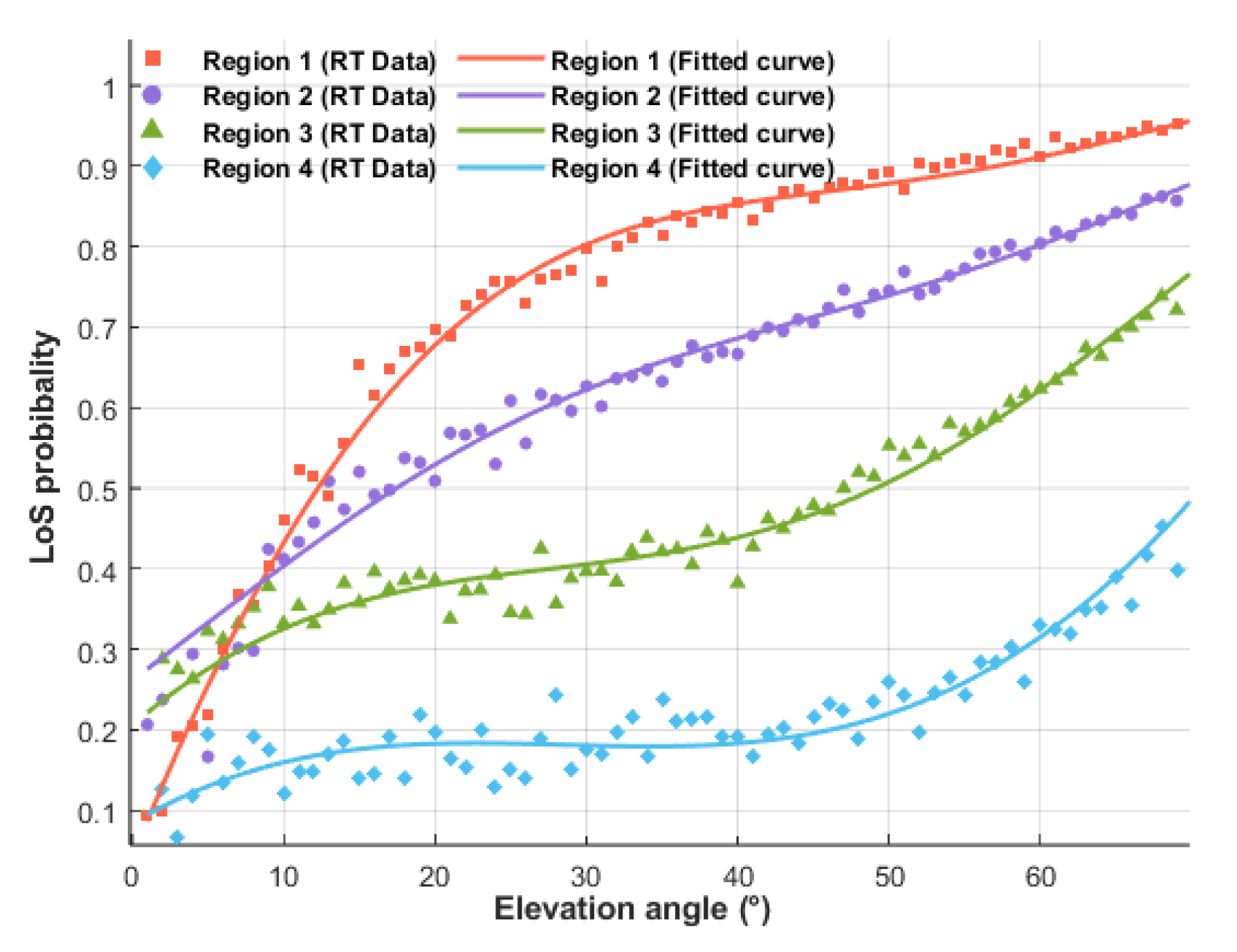
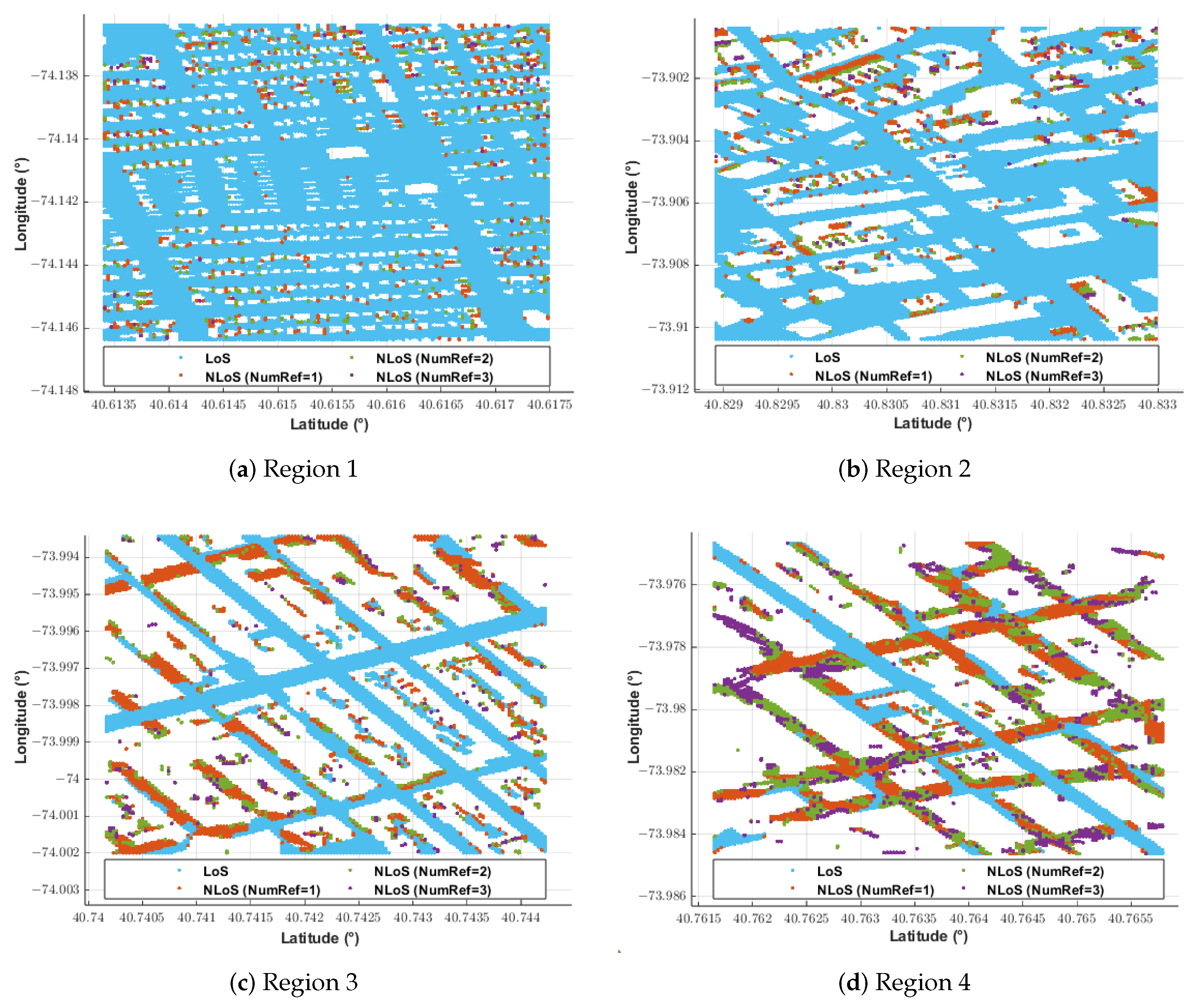
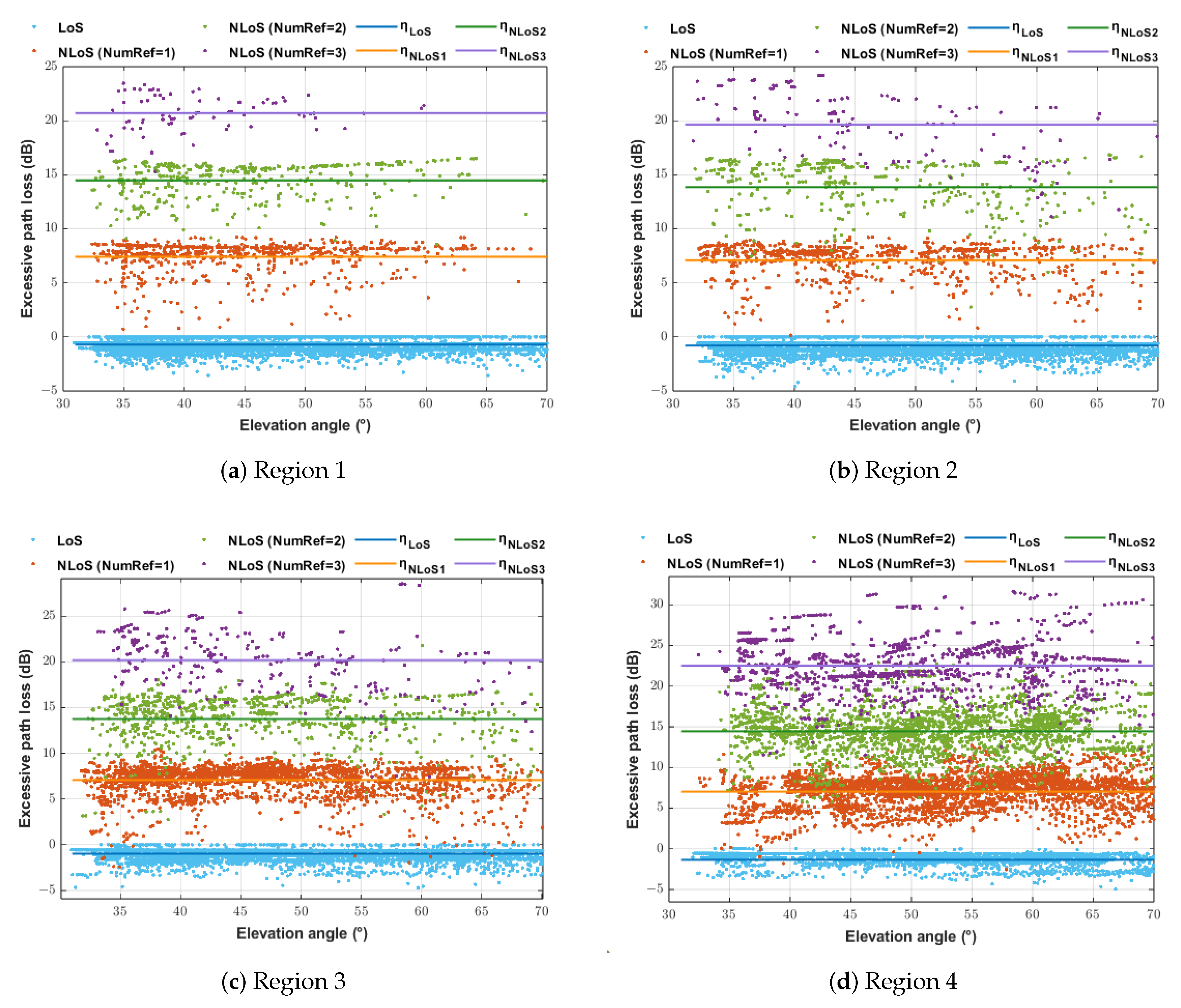
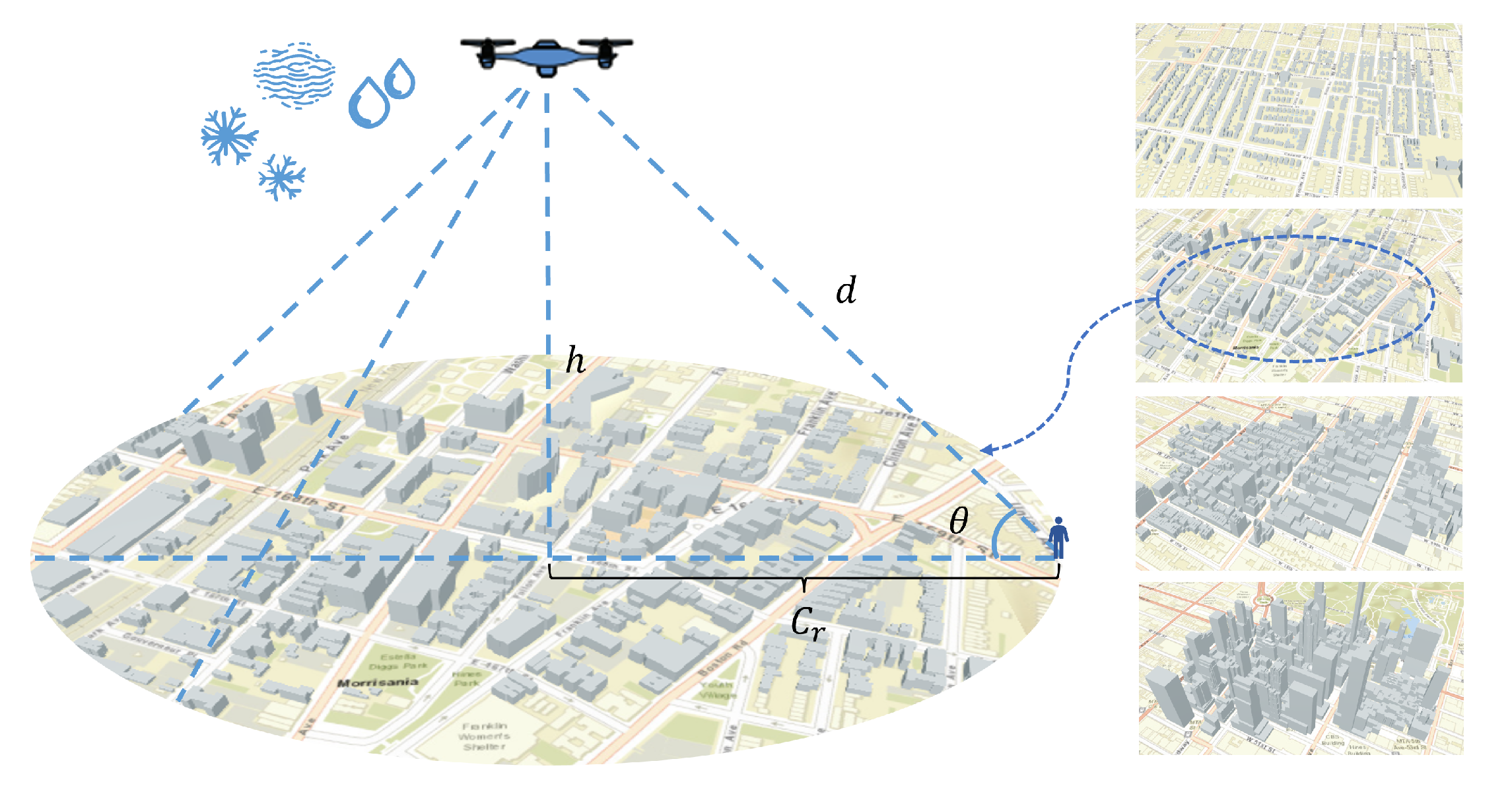
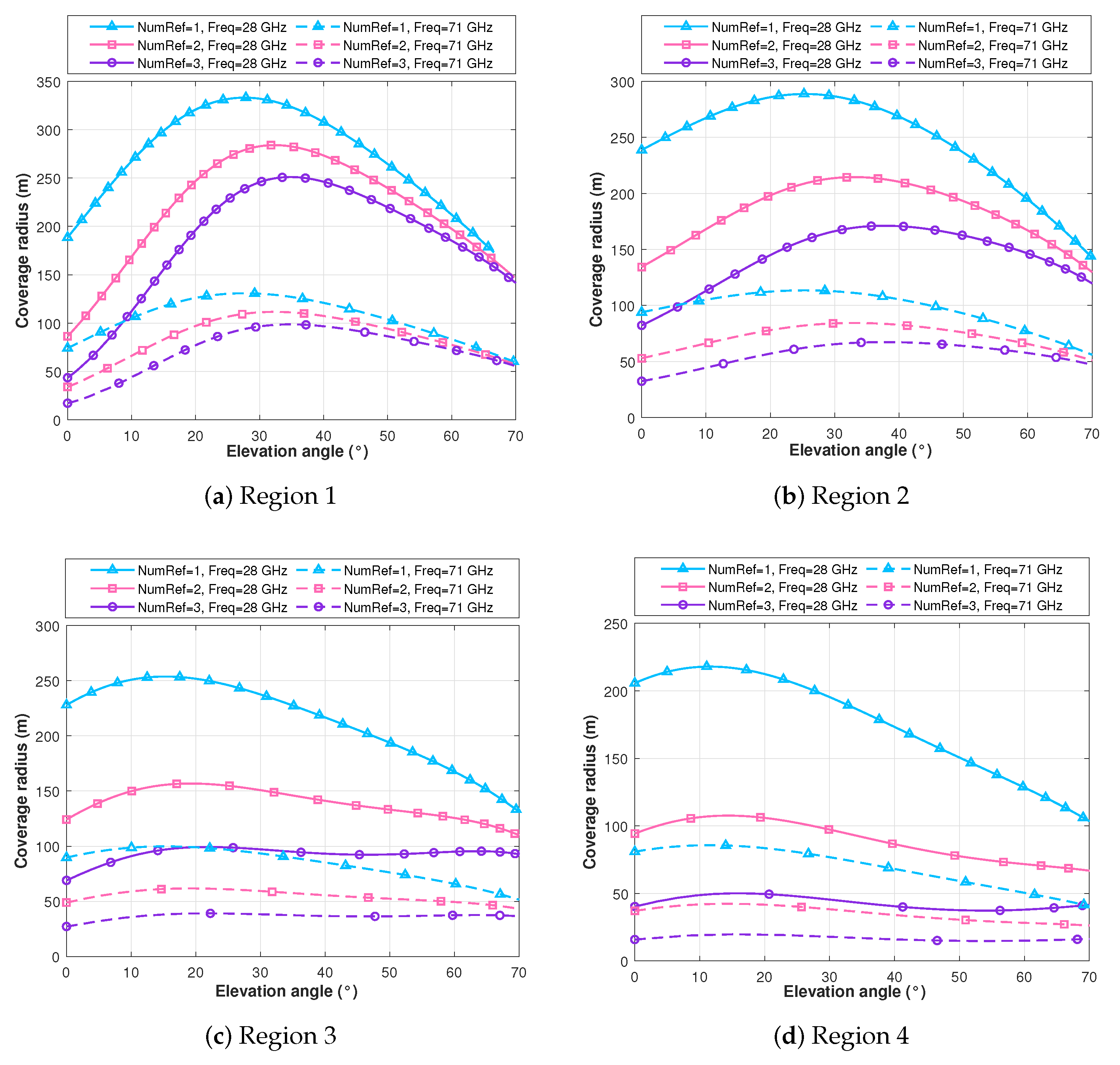

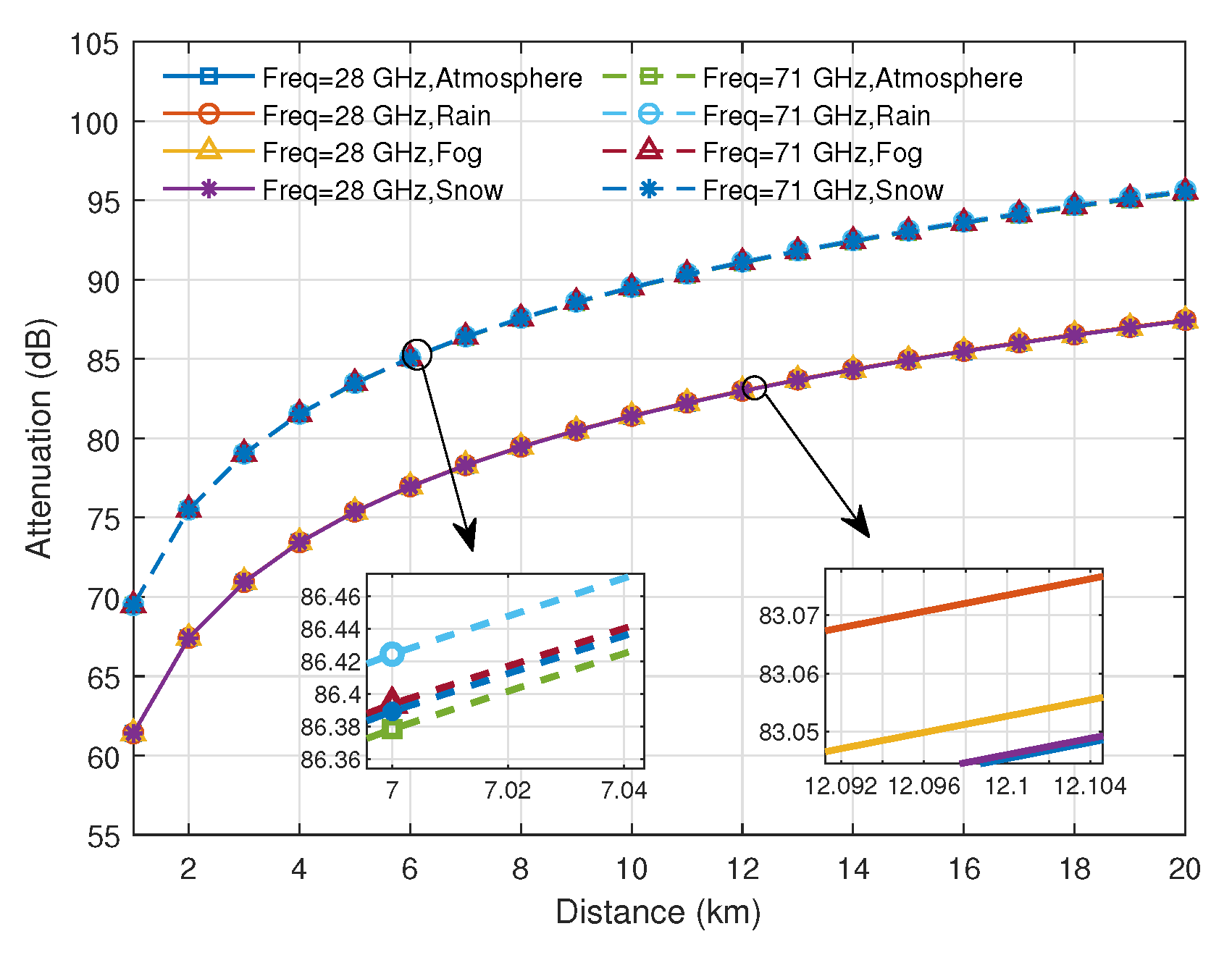
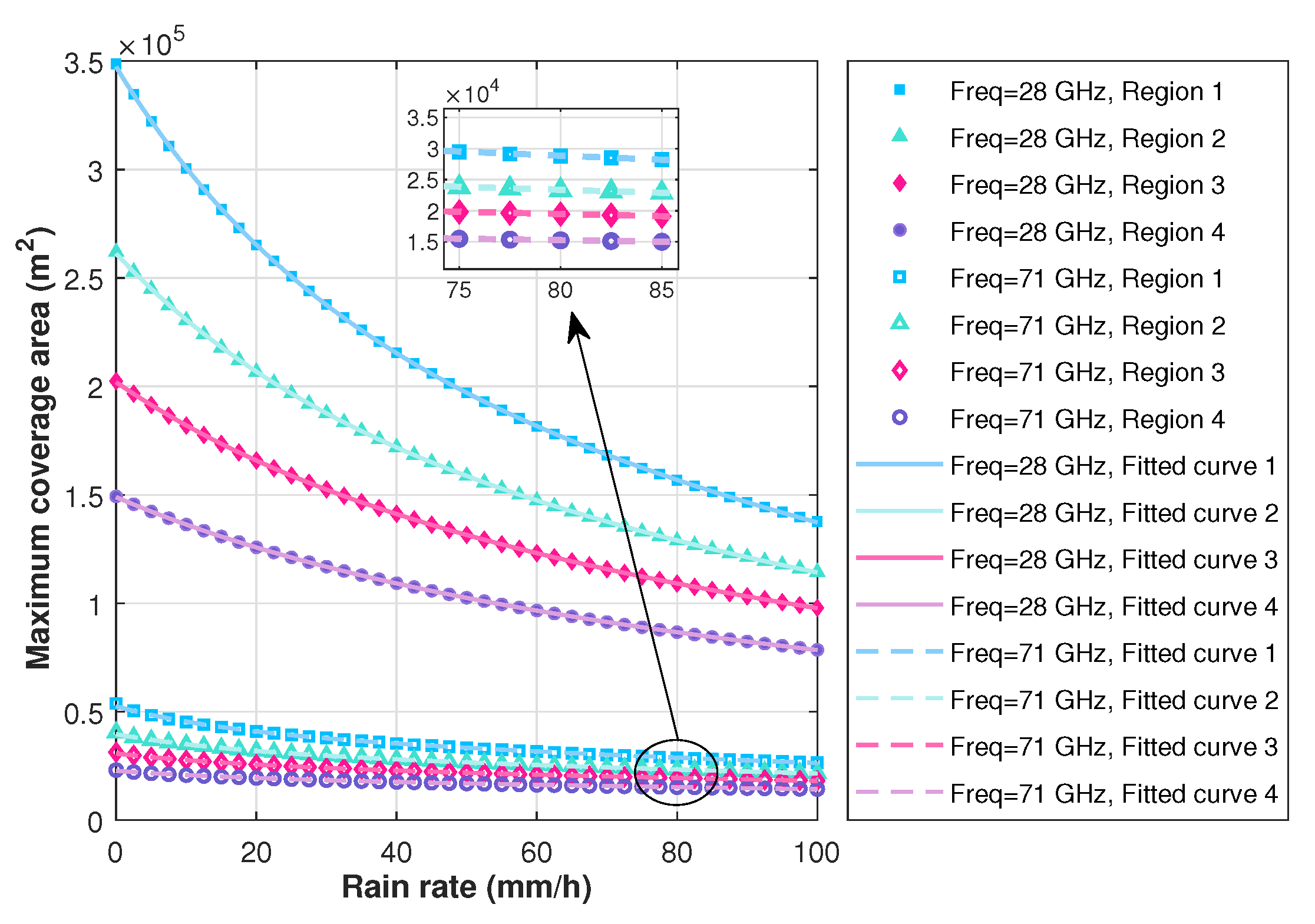
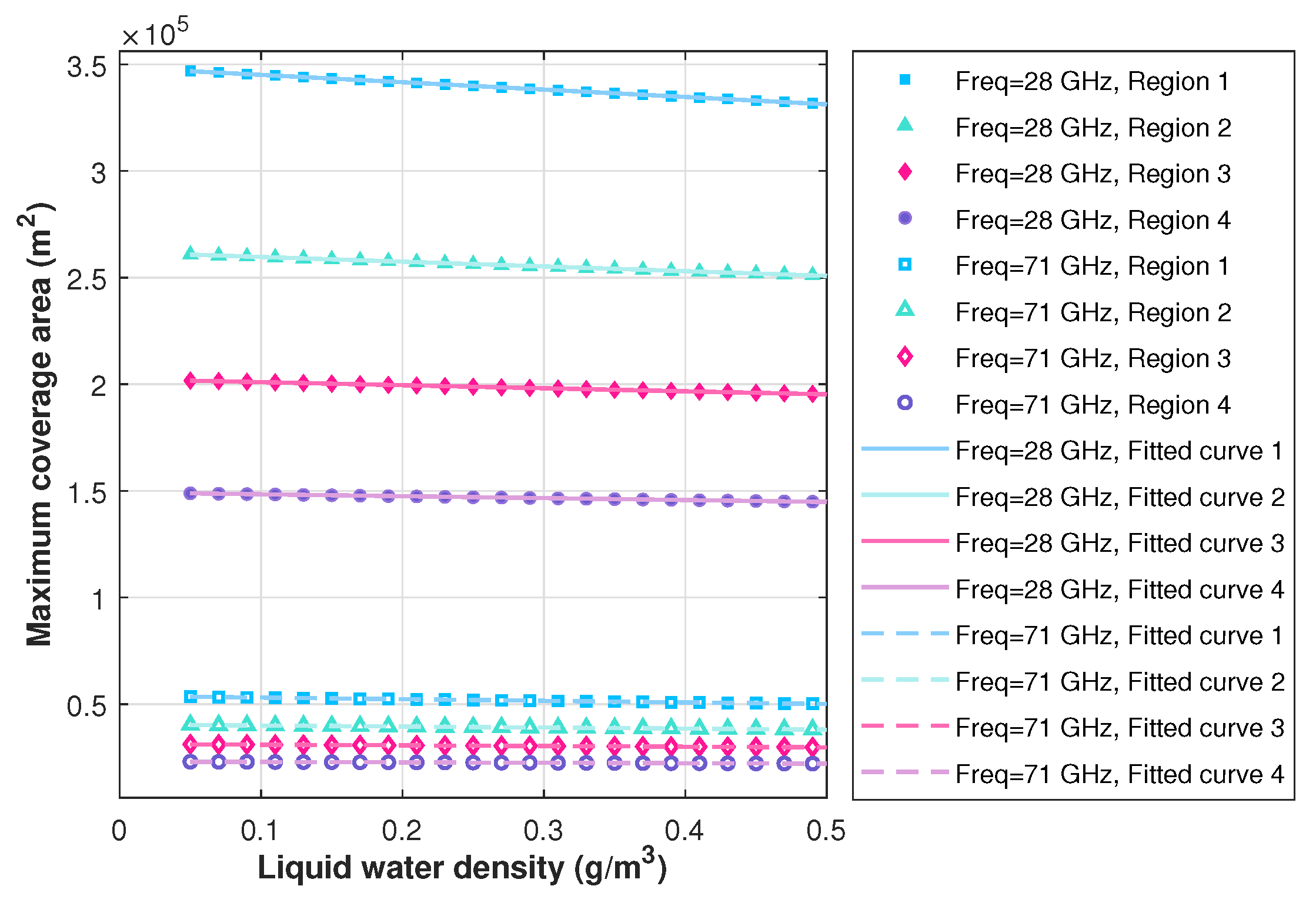
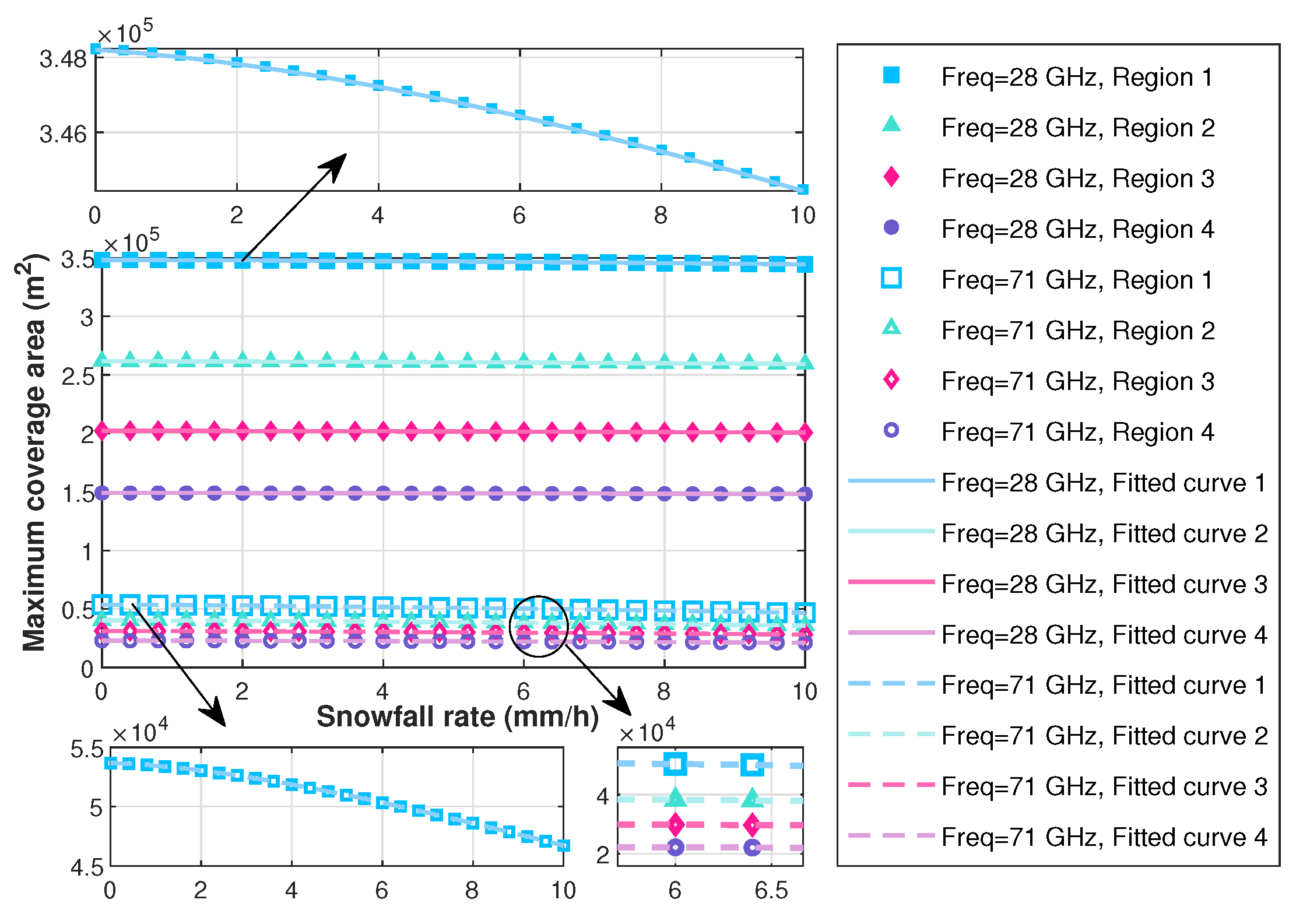
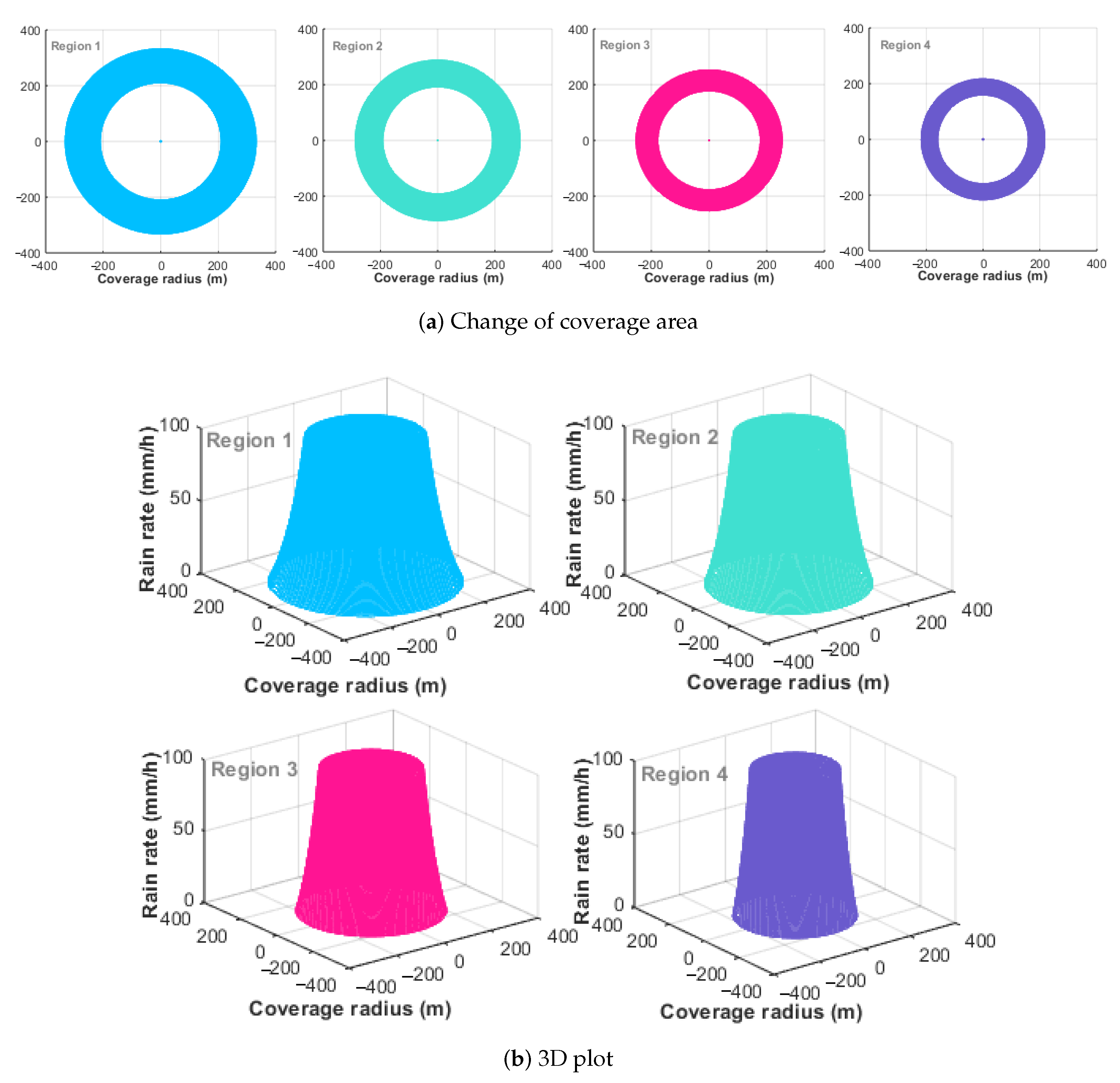
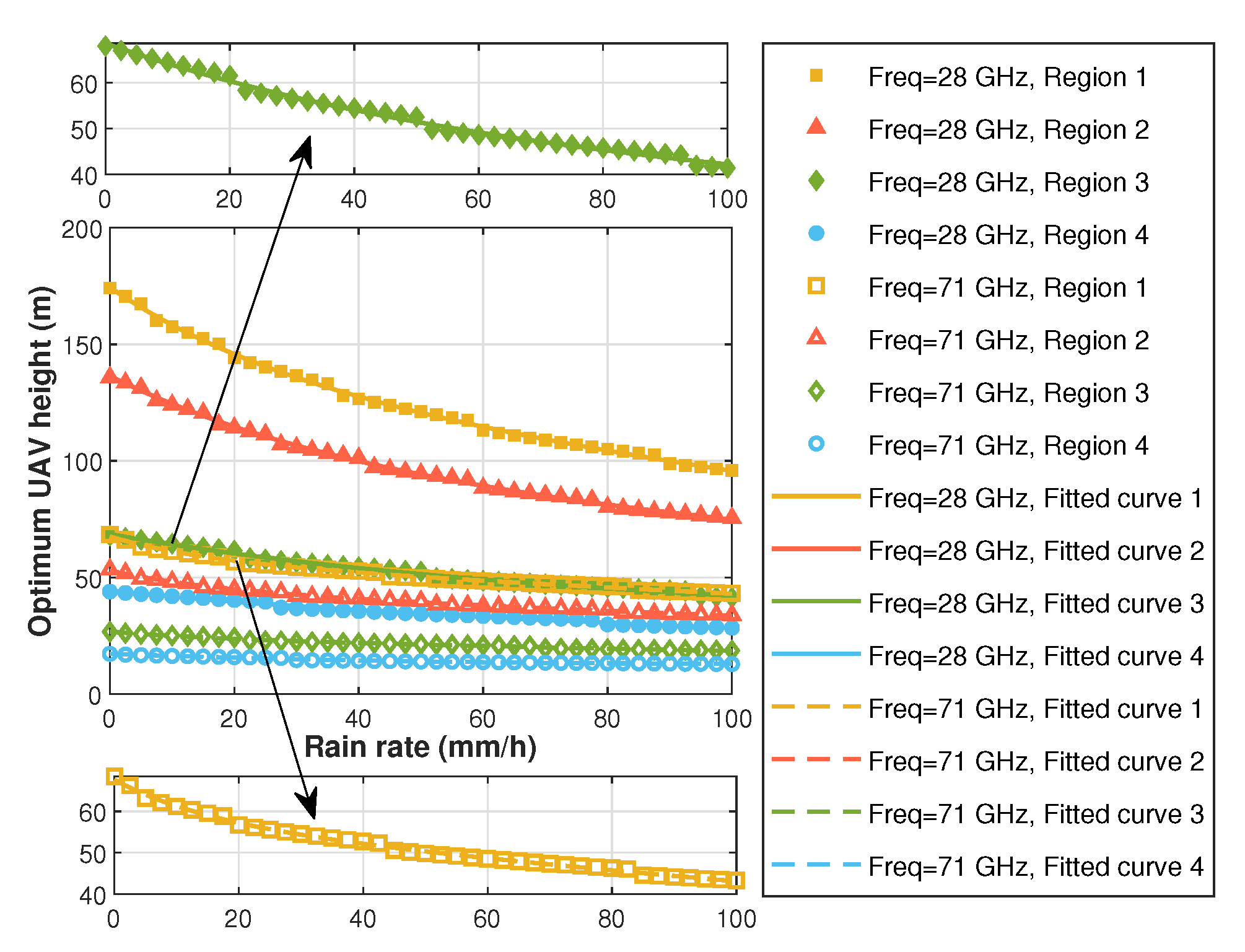
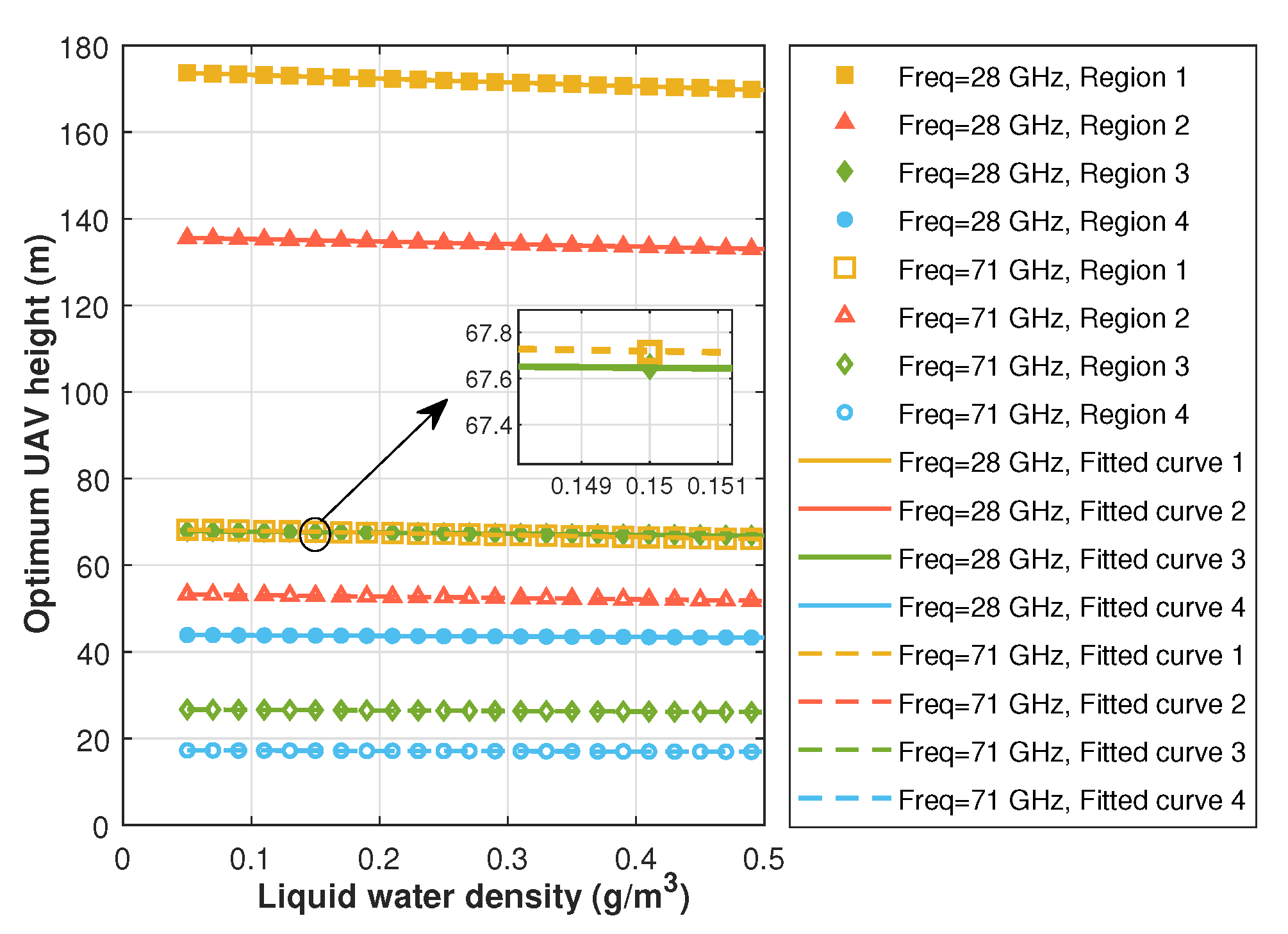

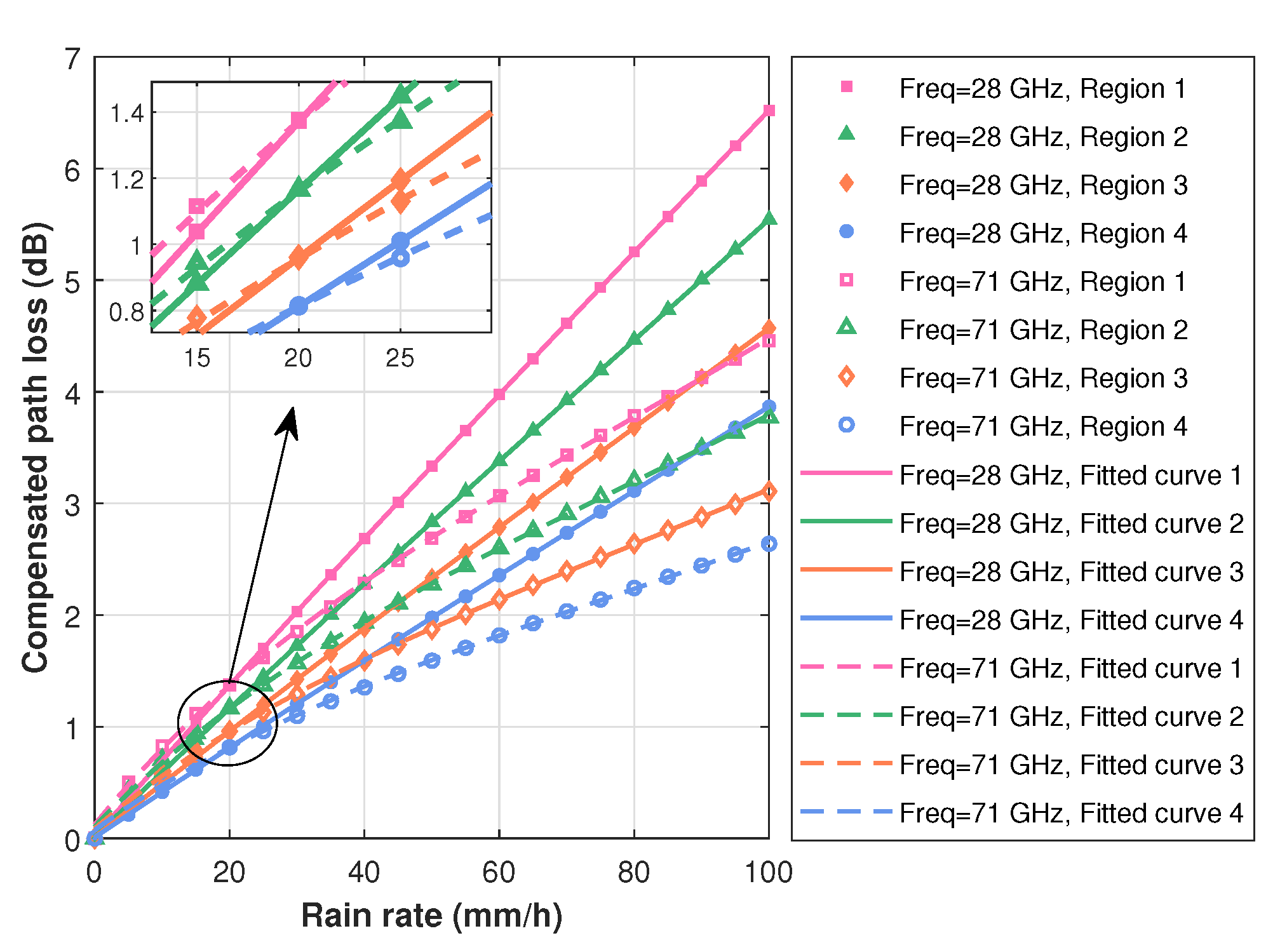
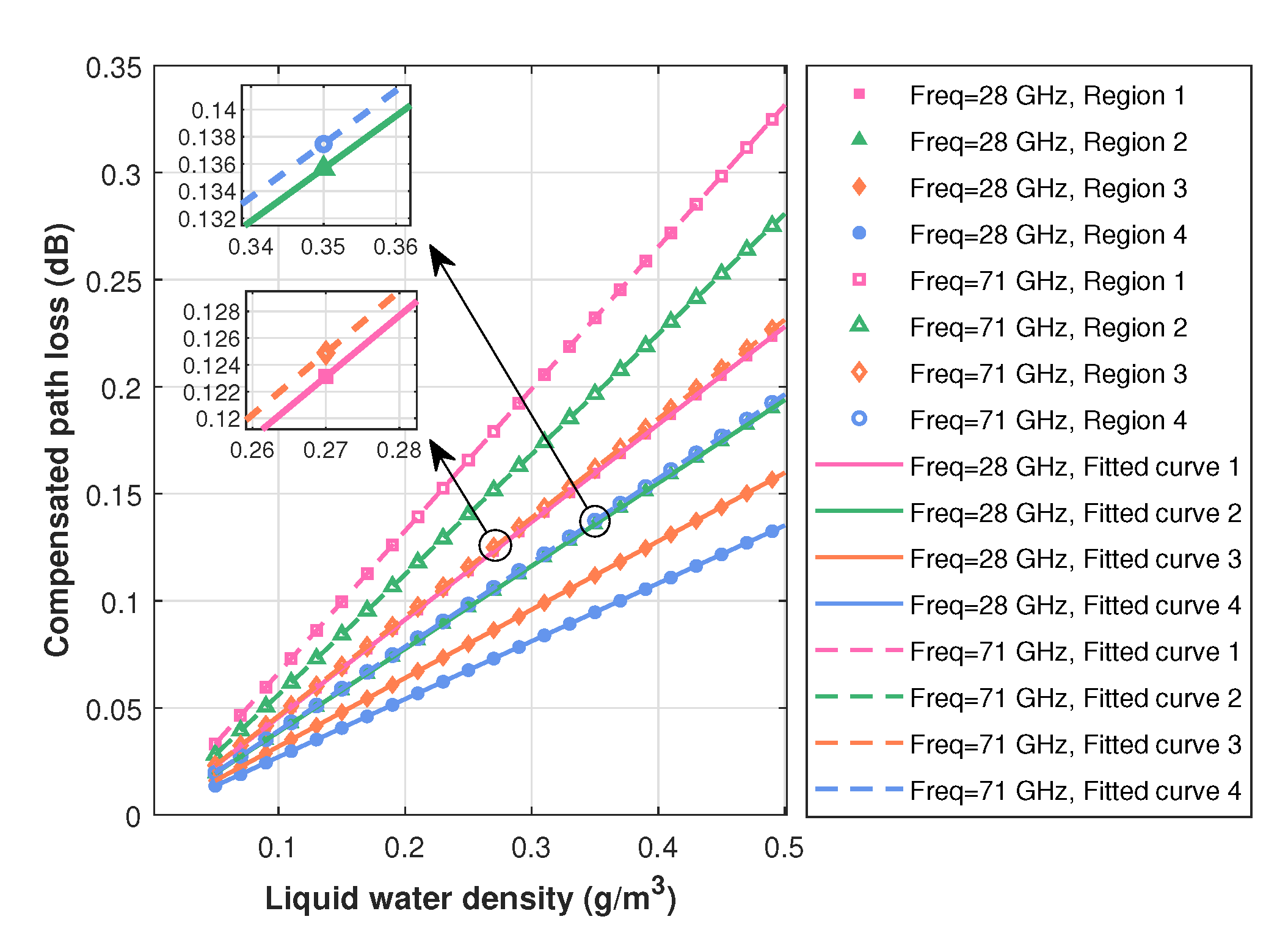

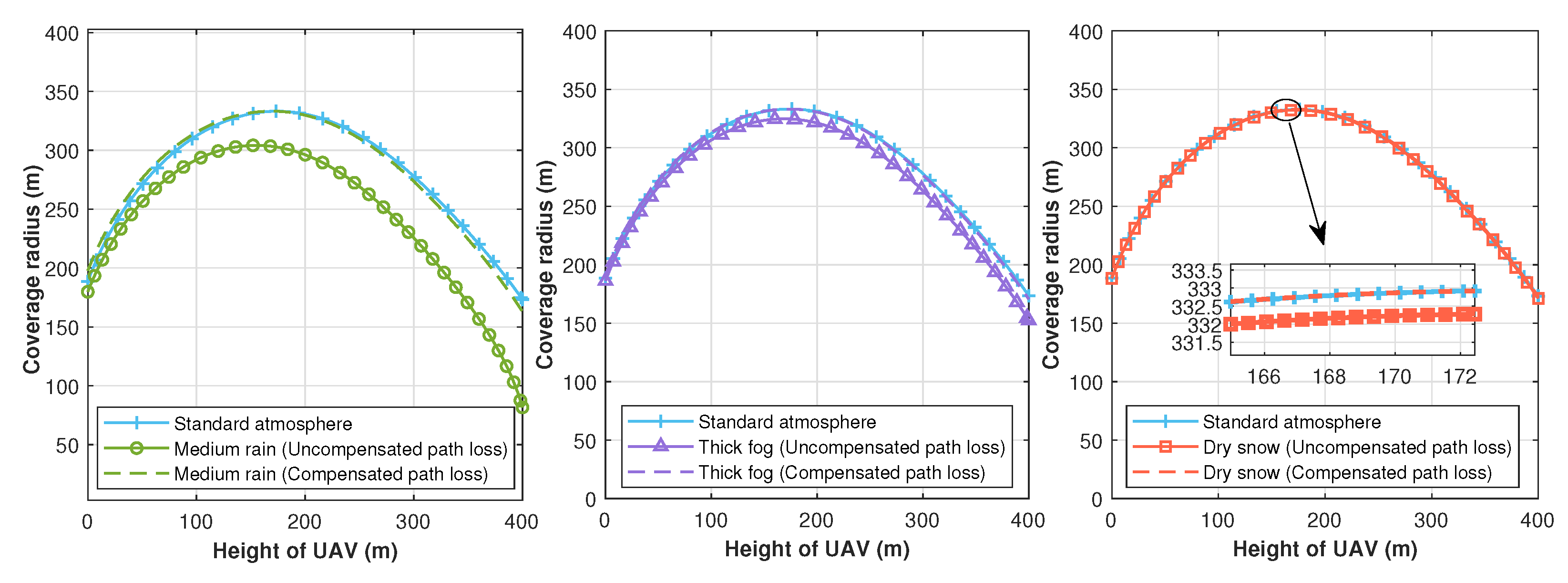

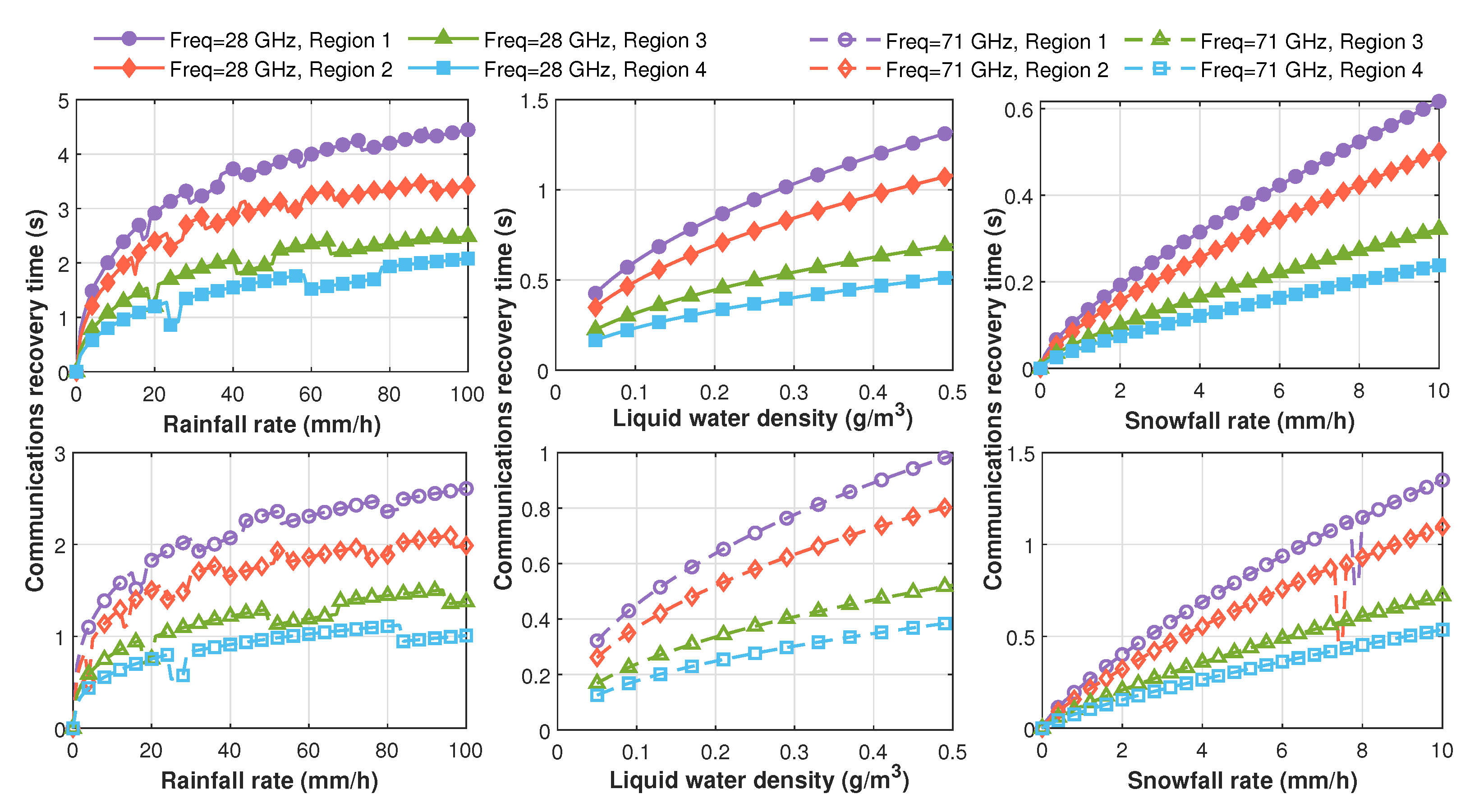
| Regions/Parameters | i | j | k | l | m | n |
|---|---|---|---|---|---|---|
| Region 1 | 4.983 | 0.03925 | −0.7442 | 4.077 | 0.04385 | 2.148 |
| Region 2 | 0.9833 | 0.01213 | 0.2867 | 0.03389 | 0.09113 | −0.5077 |
| Region 3 | 1.718 | 0.0317 | −0.3507 | 1.132 | 0.04341 | 2.362 |
| Region 4 | 3.659 | 0.006567 | −0.1354 | 0.6815 | 0.03597 | 2.128 |
| Regions | Frequency | ||||
|---|---|---|---|---|---|
| Region 1 | 28 GHz | −0.7108 | 7.4100 | 14.4860 | 20.6935 |
| Region 1 | 71 GHz | −0.7102 | 7.4154 | 14.4935 | 20.7025 |
| Region 2 | 28 GHz | −0.8005 | 7.0873 | 13.8626 | 19.6476 |
| Region 2 | 71 GHz | −0.7998 | 7.0924 | 13.8696 | 19.6561 |
| Region 3 | 28 GHz | −0.9833 | 7.0834 | 13.7405 | 20.1763 |
| Region 3 | 71 GHz | −0.9825 | 7.0887 | 13.7476 | 20.1849 |
| Region 4 | 28 GHz | −1.3496 | 7.0300 | 14.4386 | 22.5115 |
| Region 4 | 71 GHz | −1.3486 | 7.0357 | 14.4459 | 22.5205 |
| Regions | NumRef | 28 GHz | 71 GHz |
|---|---|---|---|
| Region 1 | 1 | 333.1 | 130.9 |
| 2 | 284.0 | 111.6 | |
| 3 | 251.0 | 98.7 | |
| Region 2 | 1 | 288.7 | 113.5 |
| 2 | 214.6 | 84.4 | |
| 3 | 171.1 | 67.3 | |
| Region 3 | 1 | 253.8 | 99.8 |
| 2 | 156.8 | 61.7 | |
| 3 | 99.3 | 39.1 | |
| Region 4 | 1 | 218.0 | 85.7 |
| 2 | 107.6 | 42.4 | |
| 3 | 50.1 | 19.8 |
| Regions | Region 1 | Region 2 | Region 3 | Region 4 | ||||
|---|---|---|---|---|---|---|---|---|
| NumRef | 2 | 3 | 2 | 3 | 2 | 3 | 2 | 3 |
| 28 GHz | 15% | 25% | 26% | 41% | 38% | 61% | 51% | 77% |
| 71 GHz | 15% | 25% | 26% | 41% | 38% | 61% | 51% | 77% |
| Regions | Weather | 28 GHz | 71 GHz |
|---|---|---|---|
| Region 1 | gas | 333.1 | 130.9 |
| snow | 332.3 | 127.6 | |
| fog | 324.8 | 126.3 | |
| rain | 304.2 | 118.4 | |
| Region 2 | gas | 288.7 | 113.5 |
| snow | 288.1 | 111.0 | |
| fog | 282.6 | 110.1 | |
| rain | 267.0 | 104.1 | |
| Region 3 | gas | 253.8 | 99.8 |
| snow | 253.4 | 98.0 | |
| fog | 249.3 | 97.3 | |
| rain | 237.8 | 92.8 | |
| Region 4 | gas | 218.0 | 85.7 |
| snow | 217.7 | 84.4 | |
| fog | 214.7 | 83.9 | |
| rain | 206.1 | 80.6 |
| Regions | Weather | 28 GHz | 71 GHz |
|---|---|---|---|
| Region 1 | snow | 0.24% | 2.52% |
| fog | 2.49% | 3.51% | |
| rain | 8.68% | 9.55% | |
| Region 2 | snow | 0.21% | 2.20% |
| fog | 2.11% | 3.00% | |
| rain | 7.52% | 8.28% | |
| Region 3 | snow | 0.16% | 1.80% |
| fog | 1.77% | 2.51% | |
| rain | 6.30% | 7.01% | |
| Region 4 | snow | 0.14% | 1.52% |
| fog | 1.51% | 2.10% | |
| rain | 5.46% | 5.95% |
| Region 1 Weather | Regions 2–4 | 28 GHz | 71 GHz |
|---|---|---|---|
| Region 1 Snow | Region 2 | 13.30% | 13.01% |
| Region 3 | 23.74% | 23.20% | |
| Region 4 | 34.49% | 33.86% | |
| Region 1 Fog | Region 2 | 12.99% | 12.83% |
| Region 3 | 23.25% | 22.96% | |
| Region 4 | 33.90% | 33.57% | |
| Region 1 Rain | Region 2 | 12.23% | 12.08% |
| Region 3 | 21.83% | 21.62% | |
| Region 4 | 32.25% | 31.93% |
| Weather | Regions | 28 GHz | 71 GHz |
|---|---|---|---|
| Rain ( mm/h) | Region 1 | 210,920 | 27,280 |
| Region 2 | 147,490 | 18,814 | |
| Region 3 | 104,520 | 13,102 | |
| Region 4 | 70,740 | 8735 | |
| Fog ( ) | Region 1 | 15,530 | 3381 |
| Region 2 | 9991 | 2189 | |
| Region 3 | 6410 | 1411 | |
| Region 4 | 4028 | 886 | |
| Snow ( mm/h) | Region 1 | 3835 | 7204 |
| Region 2 | 2400 | 4536 | |
| Region 3 | 1531 | 2955 | |
| Region 4 | 956 | 1874 |
| Weather | Regions | 28 GHz | 71 GHz |
|---|---|---|---|
| Rain ( mm/h) | Region 1 | 78.29 | 25.17 |
| Region 2 | 60.31 | 19.52 | |
| Region 3 | 26.61 | 8.05 | |
| Region 4 | 15.50 | 4.39 | |
| Fog ( ) | Region 1 | 3.93 | 2.19 |
| Region 2 | 2.62 | 1.47 | |
| Region 3 | 1.09 | 0.61 | |
| Region 4 | 0.60 | 0.34 | |
| Snow ( mm/h) | Region 1 | 0.96 | 6.33 |
| Region 2 | 0.62 | 4.45 | |
| Region 3 | 0.26 | 1.30 | |
| Region 4 | 0.14 | 0.72 |
| Weather | Regions | 28 GHz | 71 GHz |
|---|---|---|---|
| Rain ( mm/h) | Region 1 | 6.5202 | 4.4548 |
| Region 2 | 5.5417 | 3.7718 | |
| Region 3 | 4.5689 | 3.1075 | |
| Region 4 | 3.8657 | 2.6386 | |
| Fog ( ) | Region 1 | 0.2052 | 0.2984 |
| Region 2 | 0.1744 | 0.2527 | |
| Region 3 | 0.1438 | 0.2082 | |
| Region 4 | 0.1217 | 0.1767 | |
| Snow ( mm/h) | Region 1 | 0.0475 | 0.6545 |
| Region 2 | 0.0404 | 0.5542 | |
| Region 3 | 0.0333 | 0.4566 | |
| Region 4 | 0.0282 | 0.3878 |
| 28 GHz | 71 GHz | ||||||||||
|---|---|---|---|---|---|---|---|---|---|---|---|
| R A I N | a | b | c | d | a | b | c | d | |||
| Region 1 | −0.03771 | −0.005918 | −0.0607 | −0.004412 | |||||||
| Region 2 | −0.03437 | −0.005317 | 7675 | −0.05787 | −0.003948 | ||||||
| Region 3 | −0.03046 | −0.004728 | 5078 | −0.05494 | −0.003493 | ||||||
| Region 4 | −0.02767 | −0.004237 | 3245 | −0.05292 | −0.003107 | ||||||
| Region 1 | 32.78 | −0.03935 | 141.7 | −0.003985 | 9.693 | −0.06505 | 57.9 | −0.002959 | |||
| Region 2 | 37.9 | −0.02704 | 98.54 | −0.003095 | 7.755 | −0.06023 | 45.27 | −0.002984 | |||
| Region 3 | 21.71 | −0.01761 | 46.9 | −0.001983 | 2.649 | −0.05612 | 24.12 | −0.002662 | |||
| Region 4 | 3.398 | −0.03786 | 41.02 | −0.00373 | 9.131 | −0.01302 | 8.184 | 0.002519 | |||
| Region 1 | 7.121 | 0.003872 | −7.108 | −0.005838 | 2.326 | 0.006901 | −2.202 | −0.02634 | |||
| Region 2 | 6.052 | 0.003872 | −6.041 | −0.005838 | 1.97 | 0.006901 | −1.864 | −0.02634 | |||
| Region 3 | 4.99 | 0.003872 | −4.981 | −0.005838 | 1.623 | 0.006901 | −1.536 | −0.02634 | |||
| Region 4 | 4.222 | 0.003872 | −4.214 | −0.005838 | 1.378 | 0.006901 | −1.304 | −0.02634 | |||
| F O G | p | q | p | q | |||||||
| Region 1 | −7516 | ||||||||||
| Region 2 | −4858 | ||||||||||
| Region 3 | −3132 | ||||||||||
| Region 4 | −8954 | −1964 | |||||||||
| Region 1 | −8.738 | 174.1 | −4.871 | 68.45 | |||||||
| Region 2 | −5.827 | 135.9 | −3.259 | 53.42 | |||||||
| Region 3 | −2.418 | 68.01 | −1.357 | 26.75 | |||||||
| Region 4 | −1.329 | 43.95 | −0.7436 | 17.29 | |||||||
| Region 1 | 0.456 | 0.6632 | |||||||||
| Region 2 | 0.3876 | 0.5615 | |||||||||
| Region 3 | 0.3196 | 0.4626 | |||||||||
| Region 4 | 0.2704 | 0.3928 | |||||||||
| S N O W | a | b | c | d | a | b | c | d | |||
| Region 1 | −0.002266 | −6398 | −0.1061 | −0.02496 | −8169 | −0.1723 | |||||
| Region 2 | −0.001847 | −3609 | −0.1137 | −0.02233 | −5959 | −0.1578 | |||||
| Region 3 | −0.001526 | −2312 | −0.113 | −0.01966 | −4513 | −0.1416 | |||||
| Region 4 | −0.001349 | −1633 | −0.1051 | −0.01796 | −3467 | −0.1256 | |||||
| Region 1 | 176.4 | −0.001107 | −1.457 | −0.1126 | 72.51 | −0.01362 | −3.481 | −0.308 | |||
| Region 2 | 136.7 | −0.000922 | −0.927 | −0.1137 | 56.12 | −0.01328 | −2.758 | −0.3517 | |||
| Region 3 | 68.37 | −0.0007619 | −0.3853 | −0.1129 | 28.48 | −0.009671 | −1.751 | −0.1414 | |||
| Region 4 | 44.18 | −0.0006713 | −0.2371 | −0.105 | 18.44 | −0.008801 | −1.163 | −0.1262 | |||
| t | u | v | w | t | u | v | w | ||||
| Region 1 | 0.06636 | −0.06659 | 0.01652 | 0.1048 | 0.9253 | −0.92941 | 0.1489 | 0.1118 | |||
| Region 2 | 0.0564 | −0.0566 | 0.01404 | 0.1048 | 0.7835 | −0.7871 | 0.1261 | 0.1118 | |||
| Region 3 | 0.0465 | −0.04667 | 0.01158 | 0.1048 | 0.6456 | −0.6485 | 0.1039 | 0.1118 | |||
| Region 4 | 0.03935 | −0.03949 | 0.009795 | 0.1048 | 0.5482 | −0.5507 | 0.08822 | 0.1118 | |||
Disclaimer/Publisher’s Note: The statements, opinions and data contained in all publications are solely those of the individual author(s) and contributor(s) and not of MDPI and/or the editor(s). MDPI and/or the editor(s) disclaim responsibility for any injury to people or property resulting from any ideas, methods, instructions or products referred to in the content. |
© 2023 by the authors. Licensee MDPI, Basel, Switzerland. This article is an open access article distributed under the terms and conditions of the Creative Commons Attribution (CC BY) license (https://creativecommons.org/licenses/by/4.0/).
Share and Cite
Song, M.; Huo, Y.; Liang, Z.; Dong, X.; Lu, T. UAV Communication Recovery under Meteorological Conditions. Drones 2023, 7, 423. https://doi.org/10.3390/drones7070423
Song M, Huo Y, Liang Z, Dong X, Lu T. UAV Communication Recovery under Meteorological Conditions. Drones. 2023; 7(7):423. https://doi.org/10.3390/drones7070423
Chicago/Turabian StyleSong, Mengan, Yiming Huo, Zhonghua Liang, Xiaodai Dong, and Tao Lu. 2023. "UAV Communication Recovery under Meteorological Conditions" Drones 7, no. 7: 423. https://doi.org/10.3390/drones7070423
APA StyleSong, M., Huo, Y., Liang, Z., Dong, X., & Lu, T. (2023). UAV Communication Recovery under Meteorological Conditions. Drones, 7(7), 423. https://doi.org/10.3390/drones7070423









